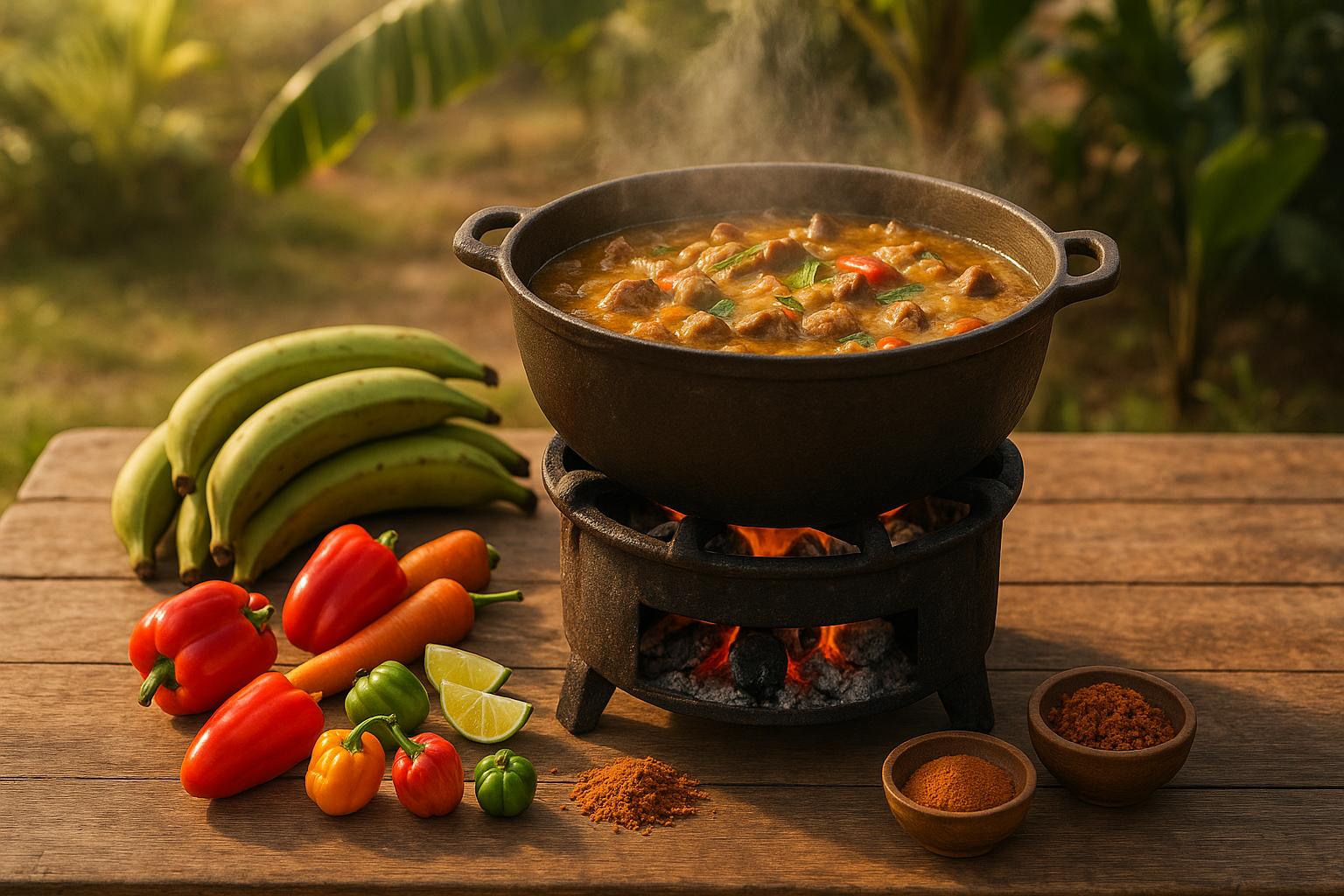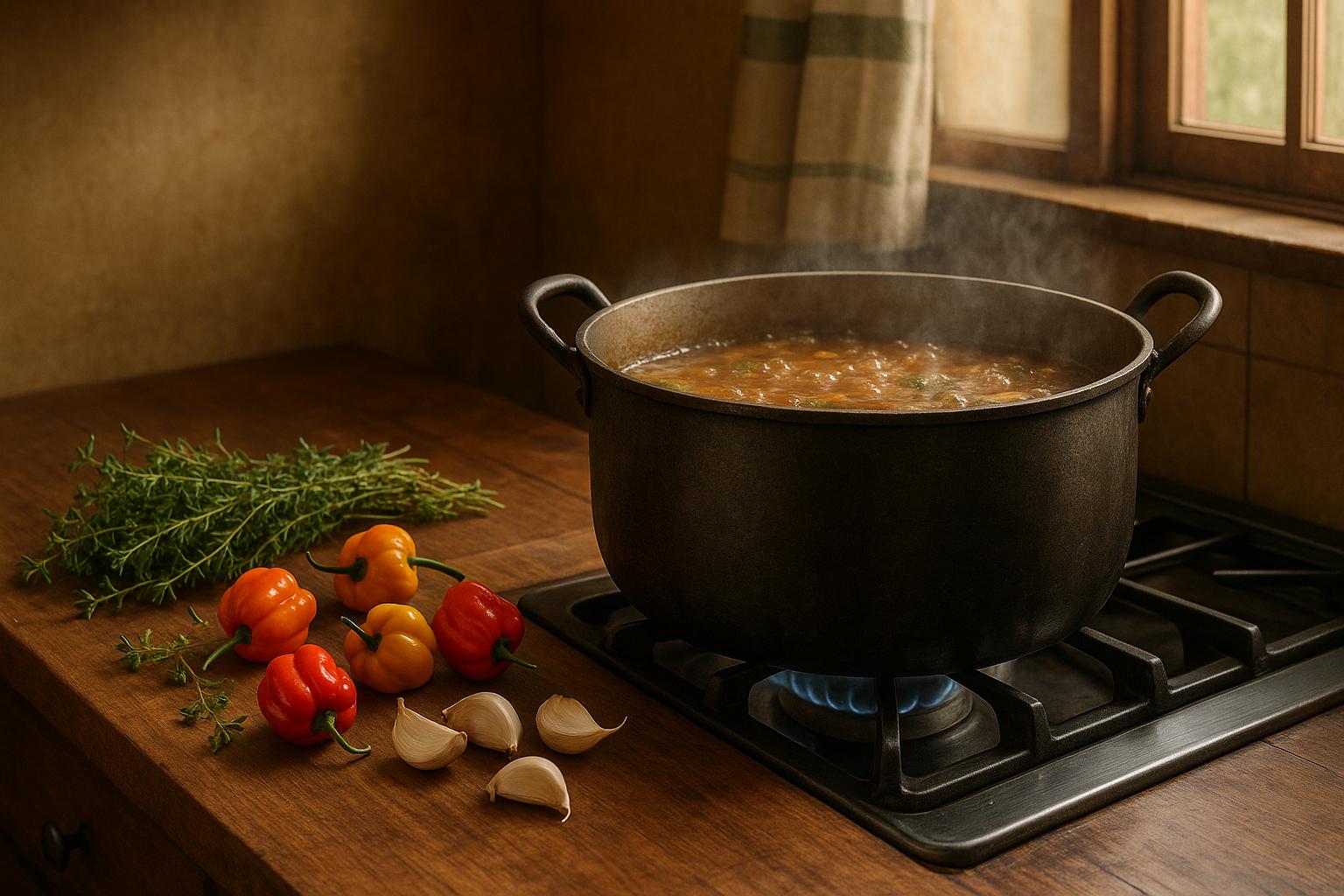Griot and Tassot are two famous Haitian pork dishes, both marinated and fried but offering unique flavors and textures. Here's the key difference:
- Griot: Made with pork shoulder, marinated in citrus and herbs, boiled until tender, then fried for a crispy exterior and juicy interior. Flavor: Savory with a hint of sweetness.
- Tassot: Can be made with pork, beef, goat, or turkey. Marinated briefly in citrus and spices, dried, then fried directly. Texture: Chewy with a crispy outside. Flavor: Spicy and tangy.
Quick Comparison Table:
| Feature | Griot | Tassot |
|---|---|---|
| Meat Options | Pork shoulder only | Pork, beef, goat, or turkey |
| Marination Time | 12–24 hours | 2–4 hours |
| Cooking Method | Boiled, then fried | Fried directly |
| Texture | Tender inside, crispy outside | Chewy inside, crispy outside |
| Flavor Profile | Savory with hints of sweetness | Spicy and tangy |
Both dishes are staples of Haitian cuisine, often served with sides like rice and beans (Diri ak Pwa) or fried plantains (Bannann Peze). Whether you prefer tender or chewy textures, these dishes showcase the bold flavors of Haitian cooking.
Basic Overview: Griot and Tassot
Griot: Crispy Fried Pork
Griot is a well-loved Haitian dish made with pork. The meat is soaked in a marinade of citrus juices, garlic, and a blend of Haitian herbs like thyme and parsley. After marinating, the pork is boiled to tenderize it and then fried, creating a juicy interior and a crispy, golden crust.
Tassot: Dried and Fried Pork
Tassot, while often made with pork, can also feature beef, goat, or turkey. The meat is briefly marinated in a mixture of citrus, garlic, and hot peppers. Afterward, it’s fried, resulting in a chewy texture with a crisp outer layer.
Common Features
Both dishes are staples of Haitian cuisine and highlight its vibrant flavors. Here’s a quick comparison:
| Feature | Griot | Tassot |
|---|---|---|
| Base Marinade | Citrus, garlic, herbs | Citrus, garlic, spices |
| Texture | Tender inside, crispy outside | Chewy with a crispy exterior |
| Flavor Profile | Savory with hints of sweetness | Spicy and tangy |
| Cooking Method | Marinate, boil, then fry | Marinate and fry |
| Meat Options | Pork only | Pork, beef, goat, or turkey |
This breakdown highlights the unique characteristics of each dish while showcasing their shared roots in Haiti's culinary heritage. Next, we’ll explore the ingredients and techniques that bring these dishes to life.
HOW TO: Cooking GRIOT w/ Pork & Turkey Haitian Style | A ...
Recipe Components and Methods
Here’s a closer look at how to prepare each dish, breaking it down into simple steps.
Griot Main Ingredients
To make Griot, gather the following:
- Main Protein: 2–3 pounds of pork shoulder, cut into 1.5-inch cubes
- Marinade Base:
- Fresh lime juice and sour orange juice
- Minced garlic cloves
- Fresh thyme and parsley
- Scotch bonnet peppers (adjust spice level to your liking)
- Sea salt and black pepper
Once you have your ingredients ready, follow these steps to create this flavorful dish.
Making Griot Step-by-Step
Griot is prepared in three main stages, each contributing to its rich flavor and texture:
- Marination Phase
Rinse the pork in lime juice, then pat it dry. Mix the citrus juices, minced garlic, herbs, and spices to create the marinade. Submerge the pork completely and refrigerate for 12–24 hours.
- Braising Phase
Transfer the marinated pork and its marinade to a pot, add enough water to cover, and bring it to a boil. Lower the heat and simmer for about 1.5 hours, or until the pork is fork-tender. Drain the liquid and let the pork cool slightly.
- Frying Phase
Fry the pork in batches at 350°F for 5–7 minutes, or until it turns golden brown.
Now, let’s move on to the steps for preparing Tassot.
Making Tassot Step-by-Step
- Quick Marinade
Marinate the meat for 2–4 hours with:
- Citrus juices
- Minced garlic
- Hot peppers
- Salt and pepper
- Drying Process
After marinating, pat the meat dry. This step is crucial for achieving Tassot's distinct texture.
- Direct Frying
Fry the meat in oil at 375°F until it’s crispy and golden.
| Preparation Step | Griot | Tassot |
|---|---|---|
| Marination Time | 12–24 hours | 2–4 hours |
| Pre-cooking | Boiled until tender | None |
| Frying Temperature | 350°F | 375°F |
| Final Texture | Crispy outside, tender inside | Crispy outside, chewy inside |
Main Differences Between Griot and Tassot
Griot and Tassot stand apart in both how they’re prepared and their flavor profiles. Let’s break down what makes each dish unique.
Side-by-Side Comparison
| Characteristic | Griot | Tassot |
|---|---|---|
| Meat Options | Pork shoulder only | Beef, goat, or turkey |
| Marination Time | Longer marination | Shorter marination |
| Cooking Method | Boiled, then fried | Fried directly |
| Texture | Tender inside, crispy outside | Chewy inside, crispy outside |
| Flavor Profile | Savory with a hint of sweetness | Spicy and tangy |
| Preparation Steps | More steps involved | Fewer steps, simpler |
The cooking methods are key to their distinct textures and flavors. Griot’s boiling step before frying ensures a tender interior, while Tassot skips this step, resulting in a chewier texture with bold, spicy flavors.
sbb-itb-80c33ff
History and Serving Methods
Griot in Haitian Cuisine
Griot is a staple of Haitian tradition, known for its flavorful marination in a blend of citrus, garlic, and herbs. After marinating, the pork is fried to a crisp, making it a centerpiece for community gatherings and celebrations.
Tassot's Origins
Tassot began as a way to preserve meat in tropical Haiti. Over the years, it evolved into a spicy dish prepared with meats like beef, goat, or turkey. This rich culinary history highlights the importance of pairing these dishes with traditional sides to complete a Haitian meal.
Common Side Dishes
Haitian pork dishes are typically served with simple yet flavorful sides that enhance the meal.
| Side Dish | Description |
|---|---|
| Diri ak Pwa | Rice and beans |
| Bannann Peze | Fried plantains |
Preparation and Ordering Guide
This guide provides straightforward tips for making these classic Haitian dishes at home and ordering them at restaurants.
Home Cooking Instructions
For Griot, start by marinating cubed pork shoulder in a mix of citrus juices, garlic, and Haitian spices. Let it sit for several hours or even overnight. After boiling the pork until tender, fry it until it’s golden and crispy.
For Tassot, drying is the secret to its signature texture. Marinate the meat briefly in a spicy citrus blend, then dry it thoroughly before frying it over medium-high heat.
Restaurant Ordering Guide
Both dishes are typically served with traditional sides. When ordering, ask if the Griot is crispy and if the Tassot has the dry, chewy texture it’s known for. These details can make all the difference in enjoying an authentic experience.
Finding Haitian Restaurants
Looking to enjoy these dishes without cooking? Use the directory below to find Haitian restaurants that:
- Prepare pork dishes fresh to order
- Offer traditional sides like Diri ak Pwa
- Clearly describe how dishes are prepared
- Include photos of their Griot or Tassot to help you choose
Summary
Griot and Tassot are standout dishes in Haitian cuisine, each offering a unique taste and texture. Griot is known for its crispy exterior and tender interior, while Tassot provides a drier, chewier bite. Many top Haitian restaurants in South Florida serve these dishes, offering a chance to enjoy the flavors of traditional Haitian cooking.
Whether you're dining out or preparing these dishes at home, both showcase the rich variety and depth of Haiti's culinary heritage. For restaurant suggestions and more insights into Haitian cuisine, check out HaitianFoods.org.
FAQs
How is the preparation of Griot different from Tassot?
The main difference in preparation comes down to the type of meat and how it’s handled. Griot is traditionally made with pork, which is cut into larger chunks, marinated with citrus and spices, boiled until tender, and then fried to achieve a crispy exterior. On the other hand, Tassot can be made with beef, goat, or turkey. The meat is typically cut into smaller pieces, marinated, and fried directly without boiling.
Both dishes share a flavorful marinating process, but their distinct cooking techniques give each one its unique texture and taste. Whether you’re enjoying the crispy, juicy bites of Griot or the savory, tender pieces of Tassot, both are staples of Haitian cuisine with their own special charm.
Can Tassot be made with meats other than pork, and how does it change the flavor and texture?
Yes, Tassot can also be made with beef, goat, or turkey, each offering its own unique flavor and texture. Beef Tassot tends to be hearty and slightly chewy, while goat adds a rich, gamey taste. Turkey provides a leaner, milder option that still absorbs the spices beautifully. These variations allow for flexibility while preserving the essence of this beloved Haitian dish.
What are the traditional side dishes served with Griot and Tassot in Haitian cuisine?
Haitian meals featuring Griot or Tassot are often paired with flavorful side dishes that enhance the experience. Popular choices include Pikliz, a spicy pickled cabbage and vegetable relish, and rice and beans, a staple in Haitian cooking. Fried plantains are another favorite, offering a delicious balance of sweetness and crunch. For an extra touch of authenticity, many enjoy sòs pwa, a creamy Haitian bean sauce that pairs perfectly with these dishes. These sides bring vibrant flavors and textures to every plate, making the meal both satisfying and memorable.


